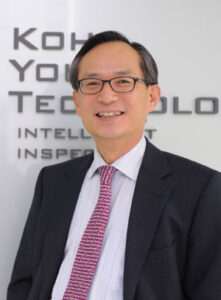The Koh Young Story: Twenty Years of Innovation – Part One – Imagining Koh Young
This series is taken from an in-depth interview with Dr. Koh on the occasion Koh Young’s 20th anniversary. It seeks to understand both the man and the company, their vision, their success and the innovative passion that is their DNA.
In the first part of the series Dr. Koh talks about his own background and how that led to the creation of Koh Young and of course to their market leading solutions.
Dr. Koh: To think back to 2002 is quite nostalgic. We established our company on May 1st that year. I was with ten dedicated experts from the robotics world who were my colleagues at the time.
My own career began in 1981. As a robotics engineer, I developed various products at companies like LG group and Mirae Corporation. When I joined LG Group’s first-ever Robotics R&D team, I was very fortunate to be given the opportunity to develop various types of robotics systems, like SCARA-type assembly robotic systems, nuclear power plant maintenance systems, and SMD mounters and test handlers.
As the head of the robotics R&D department, all I dreamed of was for our work to be recognized by customers across the globe. This drive was what kept me going through the countless all-nighters we pulled at the time. But at one point I realized that no matter how technically excellent a product was, without being a real owner of a company, it was not possible to accomplish my dream. So, I established a company for myself and my long-time colleagues.

The most important message I gave to my colleagues in the beginning, was to “wait until we find the right product to challenge”. Our future product had to be something we were familiar with, like robotics, and be highly desired by the market, our customers. Because it was so important to me to hear from customers and their experiences directly in the early stage, all we did was hands-on field research.
So, in our first 6 months, we were 24/7 out in the field. Every dinner, we gathered around to share information collected from our research. When we collected feedback from some of the potential Korean customers, we found a need for an inspection system after the printing process, because, at the time, there was nothing like that. There was no such thing as SPI! This is when we realized, the industry needed SPI.
The first challenge was to match the miniaturization of electric components and the complications of the inspection process. As electronics parts were getting smaller, it became tougher to detect the defects. After long research and exploration, our solution was to add 3D measurements to the inspection equipment. By applying proprietary 3D optics and Moiré technology to an inspection system we created our first-ever product 3D Solder Paste Inspection System, now known as 3D SPI.
How difficult was it to turn your initial idea into reality, both in terms of getting the business off the ground, but also in getting the first product ready for market?
Dr. Koh: After we had the initial idea to build a 3D measurement-based SPI system, the next steps were relatively simple. Since my colleagues and I had a solid background in industrial robot development, like that of a pick-and-place machine, building the first SPI, which had only one third of the hardware structure of a robot, was not a difficult task. But that left us with another big mission – to build intelligent software. Metaphorically, if the pick-and-place machine is the muscle, the inspection machine had to be the mind and the eyes.
Back in the early 2000s, with no machine to inspect after the printing or mounting process, a human worker had to be sitting in the line, staring at each of the components on the PCB, detecting the defects with eyes. But this was to be replaced by an inspection machine with enough software intelligence to substitute a human mind, and more accuracy than the human eye.

To our surprise, our product was greeted with a warm welcome from the European market. Our first customer in Berlin saw our product and told me that they have been looking for a product like our SPI for four long years! They were so eager to learn more about our product that we moved to the evaluation process immediately. The customer was one of the largest engineering companies in Germany, known as a leader in industry 4.0, so their evaluation standards were very high. But this was exactly what we wanted to prove our product to the market.
It was a tough process to optimize our product, but after we’d done it, our product met many other customers’ requirements and needs. Thanks to this opportunity in Germany with our first and dearest customer, we became the SPI market leader within three years of our first product launch. That customer is our VIP and I am forever indebted to them.










